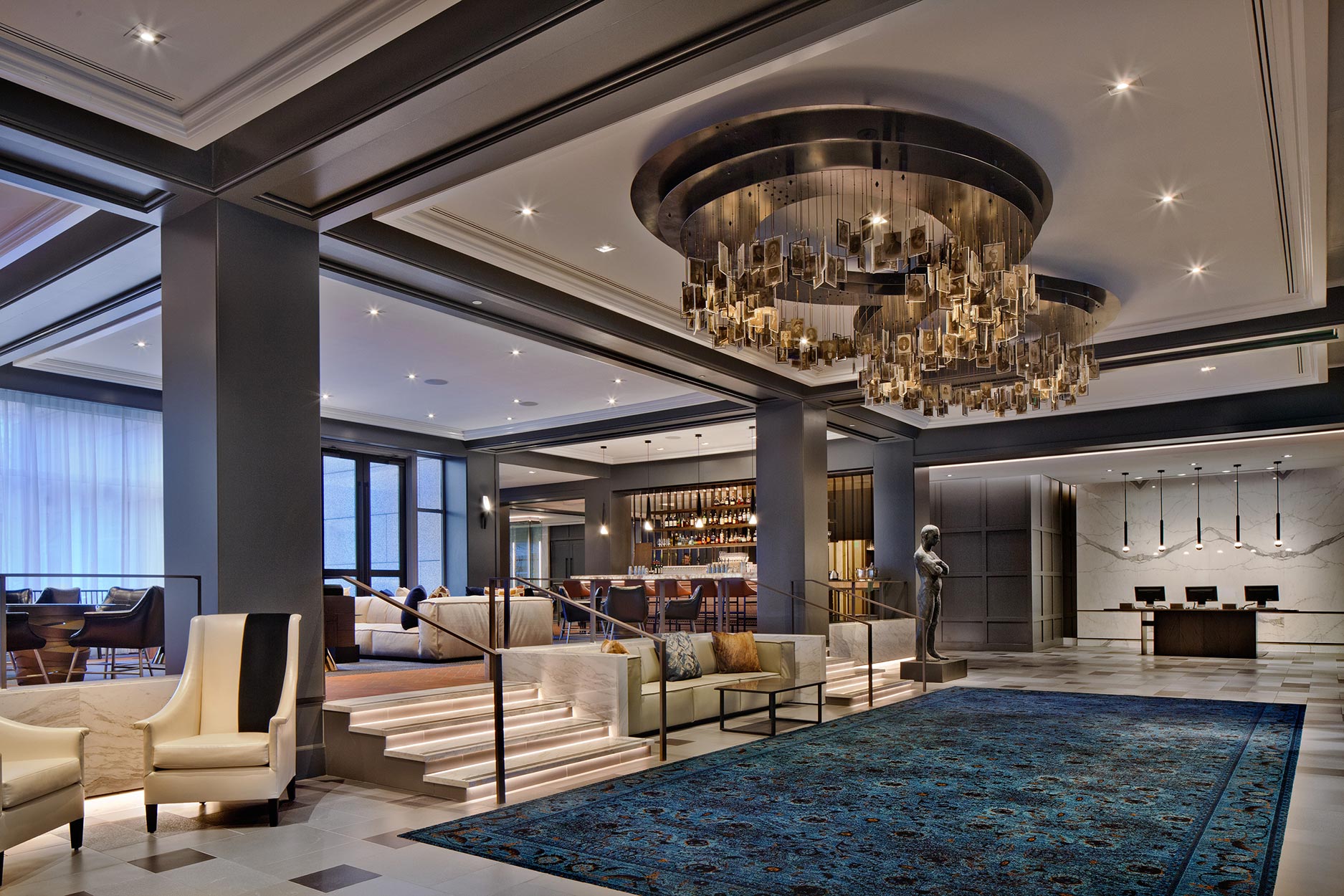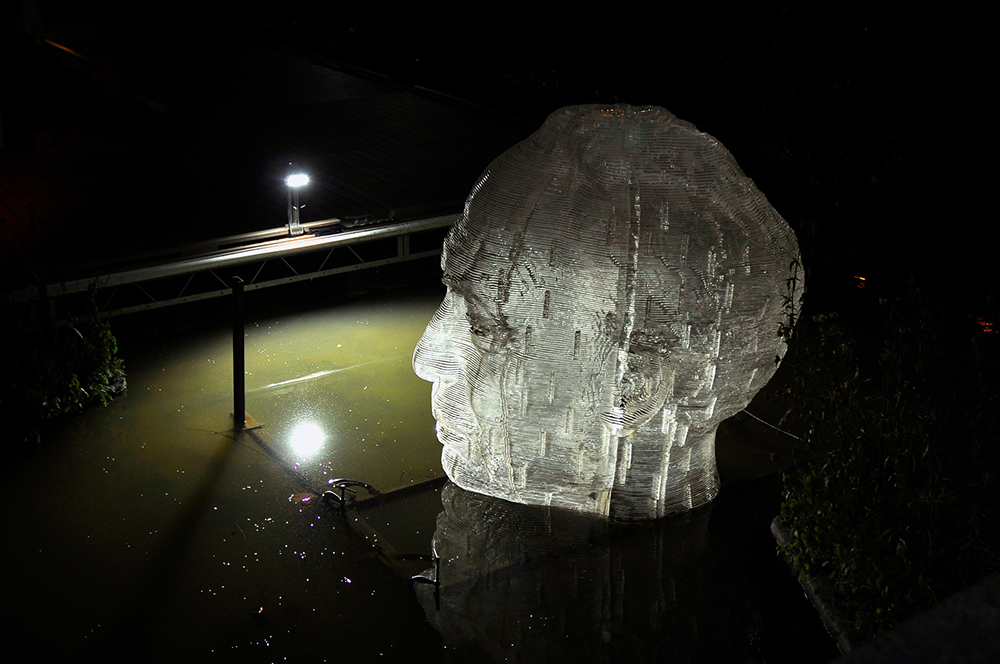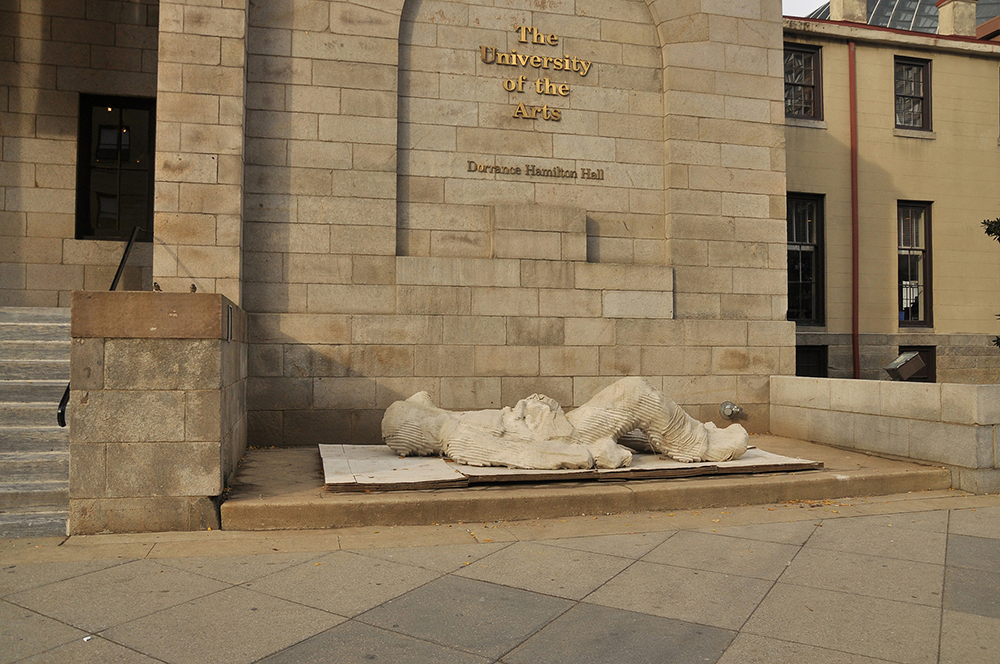Our featured artist for July is Philadelphia-based sculptor, Miguel Antonio Horn. Miguel received a certificate in 2006 from the Pennsylvania Academy of the Fine Arts and apprenticed for five years with Mexican artist Javier Marin. He creates large-scale sculptures using digital and analog processes across a variety of mediums. Prior to 2019 he contributed to exhibitions programming and public outreach for the west Philadelphia artist-run Traction Company. In 2019 he founded El Cubo as a space for experimental projects and programming.
KBAA worked with Miguel to create the custom large-scale sculptures for the lobby of The Logan Hotel, located in his hometown. During this month when we’re thinking about marquee public spaces artworks, it felt like a good time to catch up with Miguel and see what he’s been working on. In addition to the Q & A below, you can see his new featured artist page now live on our website.
Q: First things first: how are you doing? What’s life like for you as an artist and otherwise right now?
Miguel Antonio Horn: Aww, just swell, you know…all peaches, haha! Things have been a roller coaster for sure, thankfully we are healthy and safe. My days are mostly spent with my two young kids, Mira and Leo, navigating the complexities of raising children in this spiraling shit storm we are living in; they are what keeps me going. I still make a point to put in a couple hours on my practice, which at the moment is a mix of some computer-based design development at home and time in the studio on production.
Q: When people think about sculptors they don’t often think about algorithms and computers, but you use 3D modeling and technology frequently in your work. Can you tell us a little about how the emotional, creative process meets with the technical, hyper-detailed work you do during the process of creating a new work?
Miguel Antonio Horn: It keeps things fresh to be able to move back and forth between processes. In the early stages of developing pieces and projects they overlap a lot which can be so exhilarating because they feed off of each other. I try to keep that energy going all the way through production but the sheer scale of those processes can be taxing. I invest so much time in sculpting by hand, which is charged with that emotional quality and needed to develop these digital methods to translate those sensibilities through the production process. It is an ever-evolving language and the software and algorithms are part of that vocabulary.

Q: KBAA first worked with you on The Logan Hotel while you were with Traction Company. Can you share with us a little of the inspiration behind your piece “Hombre de Hierro” and how it was developed?
Miguel Antonio Horn: I really appreciated that the concept of The Logan Hotel was all about honoring Philly history. Innovation and industry plays a major role in that story and the men and women that established Philadelphia as a manufacturing powerhouse define its identity past and present. When designing the pose of this figure that welcomes guests to our city, I was thinking about those laborers whose backs this city’s legacy was built on. The people of this city are unapologetically proud of it despite all of its challenges. For me it was a chance to make a love letter to that grit and attitude of the people of my hometown. Stoic and strong the sculpture commands a presence over the lobby, It’s surface is made of raw steel plate, transformed by computer-driven machining and hand fabrication; it’s a reference to that blend of innovation and industry that we are proud of.

Q: Talk to us a little about your recent participation in the FLOW exhibition and the piece, “Abu”, a large-scale sculpture of your father’s head submerged in the Delaware River.
Miguel Antonio Horn: Abu was a deeply emotional and personal piece. In the time leading up to the project my dad was having lots of health complications and I was dealing with a lot of fear and uncertainty. I’d been reflecting on our relationship and roles as parents since having my own kids and I wasn’t sure if I’d have another chance to make this piece while he could experience it. The 8’ portrait of my dad was created out of acrylic sheet and sat at the base of low tide in the Delaware River in Philadelphia. Twice a day as the tide swelled it would slowly obscure the entire sculpture really capturing the illusive and fleeting nature of our presence and memories. The project was as epic as it was tragic. A freak storm that sent tornados through the area ripped the sculpture in half. By the time we retrieved it from the water it was battered and destroyed. It was a pretty intense end to 2019, but my dad is doing ok. I’d rather have him around than the sculpture.

Q: Tell us a little bit about El Cubo. What made you decide to start your own studio and what do you see as the mission of the work you do there? How do you see it growing in the next five years?
Miguel Antonio Horn: It was a little bit of fate pushing me into the direction I needed to go. Last year the building where I had a shared workshop and studio for nearly a decade was sold to developers. The surrounding universities were slowly consuming the neighborhood and we saw it coming for years, futilely trying to prevent the inevitable. By the time that day came my practice and production outgrew the cooperative model and I needed to focus on some big projects. I built some great friendships and community in the years of programming and projects in that neighborhood and I wanted to continue that work nearby. I was driving to my studio one day and saw a guy clearing out a garage space, a kindred spirit who built out a space that could accommodate my practice with additional studio/production and a residential/office space. To date it has mainly been dedicated to my production and for the next year that will be a focus. Beyond that the mission is to provide a space for experimental artistic production for artists. Having a residential space has opened up the possibility to host some out-of-state artists coming to do some work locally; that is one thing I’d love to make a regular program in the next five years. There is a separate studio, which I envisioned as a flexible public programming and event space in pre-COVID times, but that is on the backburner until the dust settles.
Q: In your website bio you mention your neighborhood and communities very specifically. For those of us who aren’t as familiar with Philadelphia, what do you think is important for us to understand about your city and how it shapes you as an artist?
Miguel Antonio Horn: I am an extrovert and pour a lot of energy into my communities, so everywhere I go I’m meeting neighbors. I enjoy talking to the old heads that grew up on that block and I try to respect and understand the genealogy of the neighborhood. Philly is a city of neighborhoods and each has its own identity. In the recent growth we’ve seen in the city those communities are changing and sometimes that can cause a lot of friction. I think it’s important to be a good neighbor in these times because people need each other so much more than ever. My work is constantly responding to societal issues and that is informed by my community and the problems they are confronting every day. I make work that often lives in public spaces and I need to understand the audience I’m trying to communicate with if I hope to be effective so I start with a conversation.
Q: What is something you’re working on right now that you’re excited?
Miguel Antonio Horn: Right now I’m an artist in residence (virtually now) at Brandywine Workshop and Archive funded by a grant from the NEA. As a primarily 3D artist it is so exciting to work with the master printers through BWA to make all kinds of variable editions based on the topographical patterns I generate digitally. It has opened up so many new directions and I get kind of overwhelmed with all the possibilities. It is a new kind of way of working, collaborating remotely with digital processes that I’ve only previously used for sculpture. As someone who is very involved with process and production it has been somewhat liberating to work in this way.

Q: In a normal year our team would be taking meetings across the world, but travel is just something we’re dreaming about at the moment. You spent several years living in Mexico City while you were working as an apprentice. What is on your list of “must see” sights and experiences in that city?
Miguel Antonio Horn: Oh man, we don’t have enough space here! I lived there for about five years and there are still so many parts of the city I didn’t get to see. You can’t do it in one trip. You can find a ton of websites that will give you the typical tourist sites and restaurants, so I won’t repeat those. Some off the beaten path gems: The Museo experimental el Eco is one I never tire of visiting, if you go during the art fairs week (if that ever happens again) make sure to see Salon Acme and Material Art Fair, get tacos from Los Parados and Pozole from La Teoixtla, stop into Legion Americano for great tunes and food, and street tacos from the family set up in charming la romita. Ride a pesero if you can still find one and go banda dancing.

